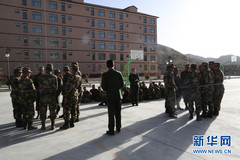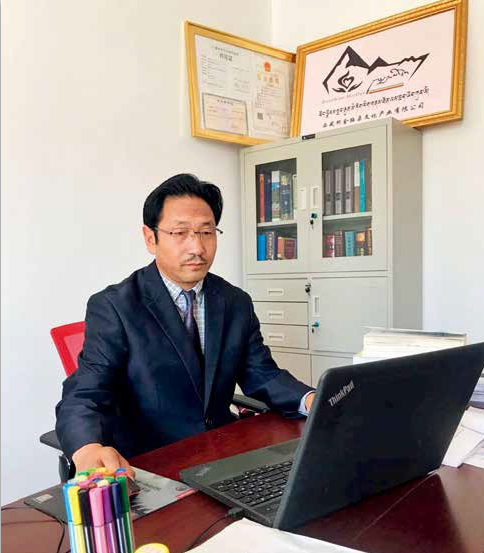Scientist's work led to first Tibet railway
Extending China's railway network to the colder climes of the Qinghai-Tibet Plateau a decade ago or Tajikistan as part of the current Belt and Road Initiative presented the problem of building a railroad on terrain subject to permafrost.
Lai Yuanming, 52, a leading permafrost expert, provided the solution. His research solved the two major problems - preventing the track from buckling due to ice melting on the roadbed, and improving thermal stability that led to Tibet's first railway.
The success of his research has brought Lai honors, including a number of science and technology awards from the Chinese central government and the local government in Gansu province. He was elected as a member of the Chinese Academy of Sciences in 2011 - the top honor for Chinese researchers - at the age of 49.
But for Lai, the greatest sense of achievement doesn't come from awards but from seeing the practical application of his research.
"The greatest honor for me is to watch technologies that are developed in the research laboratory being applied on such great projects," he said.
Such technologies have been applied to the 550 kilometers of the Qinghai-Tibet Railway built on permafrost, or permanently frozen soil, and a water transfer project in Gansu province. The latest permafrost technologies will also be used in the planned Qinghai-Tibet Expressway.
"For most people, permafrost is just a strange word in the dictionary," he said. "But for me, after spending three decades dealing with permafrost, it has gotten into my blood and has become a part of me."
Permafrost was indeed a niche research field, with little information available to Lai when he was pursuing his doctorate at the Chinese Academy of Sciences in the early 1990s. In order to gain more knowledge, Lai went to Laval University in Quebec, Canada, in 1998. Canada's area of permafrost is larger than China's, and the level of research was higher.
He returned to China in 1999 under the 100-Talent Program, which grants funds to researchers who have a minimum of two years' working experience in foreign universities or research institutions.
Despite not meeting the program's requirement on overseas work experience, the grant committee made an exception for Lai because it was difficult to find someone with expertise in both civil engineering and permafrost, and one willing to accept the arduous conditions on the plateaus, according to Cheng Guodong, a leading permafrost expert who recommended Lai for the 100-Talent Program.
In the next four years, Lai traveled regularly between the plateau and his laboratory in Lanzhou, Gansu province.
Scientist's work led to first Tibet railway
"Many people ask me how I managed to succeed. For me, it is just about having a vision of what you want to achieve, and holding true to it no matter what setbacks you encounter," Lai said.
He recalled a short story he read when he was a child that had a profound influence on him. The story tells of several ambitious young men who were competing for an offer from a law firm, which required them to prepare a case report with as many details as possible within an appropriate time. While most of the candidates finished the task quickly, one took the material home, worked on the report overnight and was given the offer.
"I think I am like the young man in the story," he said. "I seek perfection instead of a shortcut."
One of Lai's doctoral students testified to his thorough approach.
"He often appeared at the testing site to guide our experiments, and sometimes we had to repeat the experiment several times until all the experimental conditions were precisely controlled," said Zhang Mingyi, who is now a professor at the Cold and Arid Regions Environmental and Engineering Research Institute at the Chinese Academy of Sciences.
Lai said that "whether it be a railway or a highway project, our technologies will be used once the project goes across permafrost regions. Whereas other scientists publish their research results in academic journals, we publish ours on the permafrost and so gain our sense of accomplishment."
(Editor:Mirenda Wu)
Your Comment
Name E-mailRelated News
-
;
-
-

-
Tibetan medicine manufacturing room into operation in Lhasa
Tibet Autonomous Region Hospital’s Menzikang drug manufacturing laboratory held an inauguration ceremony on Dec. 21.
-
-
-

-
Tibet border defense troops organize psychological behavioral trai
On the 28th the Shigatse detachment of Tibet’s border defense troops organized a group training activity themed around “releasing inner discomforts an
-
Based in Lhasa, Tibet Vista is a Tibet travel agency that specialized in Tibet permit, and Tibet tours for both private and group travelers at a local price!
•4 Days Lhasa City Group Tour from USD 460 •8 Days Everest Base Camp Group Tour from USD 850 •15 Days Mt.Kailash Group Tour from USD 1780 •2016 Tibet Train Tours from Beijing, Shanghai, Chengdu, Xining,etc










